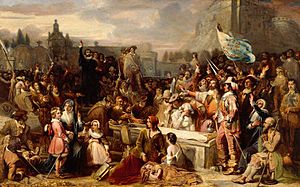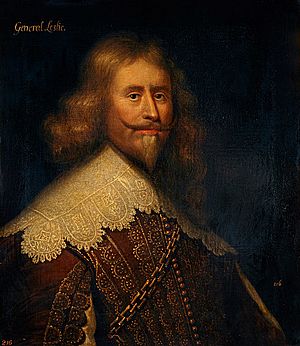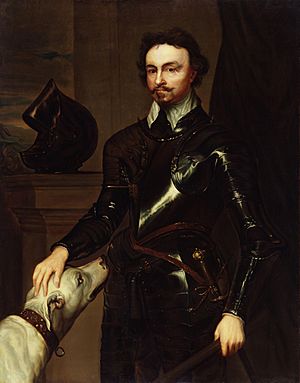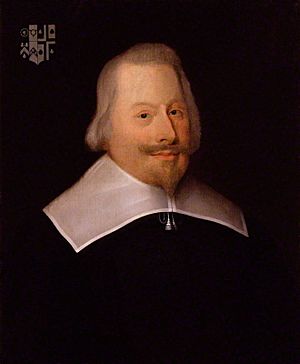Bishops' Wars facts for kids
Quick facts for kids Bishops' Wars |
|||||||
|---|---|---|---|---|---|---|---|
| Part of the Wars of the Three Kingdoms | |||||||
 Signing of the National Covenant in Greyfriars Kirkyard, Edinburgh |
|||||||
|
|||||||
| Belligerents | |||||||
| Commanders and leaders | |||||||
| Strength | |||||||
| 20,000 - 25,000 | 20,000 | ||||||
| Casualties and losses | |||||||
| 300 - 400 | 300 - 600 | ||||||
The Bishops' Wars were two short conflicts in 1639 and 1640. They were the first part of the Wars of the Three Kingdoms, a series of battles that happened in Scotland, England, and Ireland between 1639 and 1653. Other wars in this period include the Irish Confederate Wars and the English Civil Wars.
These wars started because of disagreements over how the Church of Scotland, also called the Kirk, should be run. King Charles I wanted the Kirk to be more like the Church of England. He tried to make them use the same prayer book and practices in 1637. Most Scots did not agree with this. They wanted a Presbyterian church, which is led by ministers and elders, not by bishops appointed by the King.
Many Scots signed the National Covenant in 1638. This document promised to oppose the King's changes. Those who signed were called Covenanters. Even though the Covenant did not mention bishops directly, these church leaders were seen as the King's tools. In December 1638, the General Assembly of the Church of Scotland removed all bishops. This act gave the conflict a political side, not just a religious one. After the Covenanters won the 1639 war, the Parliament of Scotland made many new laws. These laws completely changed how Scotland was governed. Their victory in 1640 confirmed these changes.
To protect their new system, the Scots made alliances. They joined with people in Ireland and England who felt the same way. Many English Puritans disliked the King's religious changes. They wanted a new Parliament of England, which had not met since 1629. When Charles I tried to fight back in 1640, things became unstable in all three kingdoms. The Irish Rebellion started in October 1641. Then, the First English Civil War began in August 1642.
Contents
Why the Wars Started

The Protestant Reformation in Scotland created the Kirk. It was Presbyterian in its structure and Calvinist in its beliefs. In the 1600s, "Presbyterian" and "Episcopalian" meant different ways of running the church. Episcopalian churches were led by bishops, often chosen by the King. Presbyterian churches were led by presbyters, who were elected by ministers and elders. Arguments about bishops were about politics and the King's power, as much as they were about religious practice.
Most Scots, whether they were Covenanters or Royalists, believed a king was chosen by God. But they disagreed on what a "well-ordered" kingdom meant. They also disagreed on who should have the final say in church matters. Royalists thought the King was the head of both church and state. Covenanters believed the King only ruled in worldly matters. They said "Christ Jesus...was King of the Kirk." There were many other reasons for the conflict too. People felt loyal to the Kirk and had their own personal reasons. For example, Montrose fought for the Covenanters at first, then became a Royalist. People often changed sides during this time.

When James VI and I became King of England in 1603, he wanted to unite the Churches of Scotland and England. He saw this as the first step to creating one big country. His son, Charles I, continued this plan. But their religious ideas were very different. Many Scots and English Puritans thought Charles's changes to the Church of England were too much like the Catholic Church.
People were very afraid of "Popery" (Catholicism). In Scotland, Catholicism was only found among some nobles and in the remote Highlands and Islands. Scots had fought in the Thirty Years' War, a terrible religious conflict in Europe. Scotland also had strong ties with the Dutch Republic, which was fighting for its freedom from Catholic Spain. Many Scots had studied in French Calvinist universities, which were closed in the 1620s.
People felt that Protestant Europe was under attack. This made them very sensitive to changes in church practices. In 1636, a new Book of Canons replaced John Knox's old rules for the Kirk. It said anyone who disagreed with the King's power in church matters would be removed from the church. In 1637, a new Book of Common Prayer was introduced. This caused anger and riots. It is said that Jenny Geddes started a riot by throwing a stool during a service in St. Giles Cathedral. Some historians now think her protest was part of a planned effort to oppose the Prayer Book. This opposition was both political and religious.
In February 1638, people from all parts of Scottish society signed the National Covenant. They promised to resist the new church changes. Most of Scotland supported the Covenant. Only Aberdeenshire and Banff were strongholds for Royalists and Episcopalians. The Marquess of Argyll and six other members of the Privy Council of Scotland supported the Covenant.
King Charles agreed to discuss the new rules at the General Assembly of the Church of Scotland. But he secretly told his supporters he would not give in. Knowing this, the Assembly met in Glasgow in December. They rejected the changes, removed bishops from the Kirk, and said they had the right to meet every year. The Marquis of Hamilton, a leading Scottish noble and Charles's main advisor on Scottish affairs, told the King that war was now unavoidable.
First Bishops' War (1639)
Charles decided to use force to get his way. He wanted to pay for the war himself, without calling Parliament. His plan was complex:
- An English army of 20,000 men would march north to Edinburgh.
- A naval force of 5,000 men, led by the Marquis of Hamilton, would land in Aberdeen. They would meet Royalist troops led by the Marquess of Huntly.
- An Irish army, led by the Earl of Antrim, would invade western Scotland from Carrickfergus. They would join forces with Royalist clans.
This plan was too complicated, and Charles did not have enough money. Many English people also supported the Covenanters. The Scots quickly took control of Dumbarton, stopping any Irish landing. In March, Montrose took Aberdeen, so Hamilton could not land his troops there. In April, Royalist leader Lord Banff took Aberdeen back after two small fights. In one of these, called the Trot of Turriff, David Prat became the first person killed in the Wars of the Three Kingdoms.
The English army gathered at Berwick-upon-Tweed on the border. It had about 15,000 men. But most were untrained recruits from local militias. Many only had bows and arrows. Charles tried to hire foreign soldiers from the Spanish Netherlands to make up for this. This made people accuse him of using foreign Catholics against his own people.

A Scottish army of 16,500 men was camped nearby, led by the experienced soldier Alexander Leslie. Both armies had many professional soldiers who had fought in European wars. But Charles gave the top English commands to his friends, who mostly lacked experience.
Charles joined his troops at Berwick on May 30. He said he would not invade Scotland if the Covenanter army stayed ten miles north of the border. Leslie moved his army to Kelso, which was within the ten-mile limit. But neither side really wanted to fight. On June 11, talks began. They ended with the Pacification of Berwick on June 19. This agreement said all disagreements would be sent to the General Assembly or the Parliament of Scotland to be solved. However, both sides saw this as a temporary break and kept getting ready for another fight.
The only important battle of this war happened on June 18. It was the Battle of the Brig of Dee south of Aberdeen. Royalist forces under Viscount Aboyne fought Montrose. The Covenanters won, but very few people were killed.
Between the Wars

The Kirk's General Assembly met again in August 1639. They confirmed the decisions made in Glasgow. The Scottish Parliament then approved these decisions. When Charles's representative, Lord Traquair, tried to stop Parliament, his action was called illegal. Parliament continued to meet. They passed many new laws that completely changed Scotland's government. These included having Parliament meet every three years and making the Covenant required for all public officials.
Charles's advisors told him the only way to pay for a second war was to call the Parliament of England. In December 1639, he called Parliament for the first time since 1629. Thomas Wentworth, 1st Earl of Strafford, Charles's best advisor and Lord Deputy of Ireland, also asked the Parliament of Ireland for money. In March, they approved an army of 9,000 men to fight the Covenanters. This happened even though many Irish people who shared their religion opposed it. This shows how the Bishops' Wars caused problems in all three kingdoms.
Charles hoped this would set an example for the Short Parliament, which met in April. But Parliament, led by John Pym, demanded that Charles fix problems like ship money (a tax) before they would give him money. After three weeks of no progress, Charles closed Parliament. He would have to pay for the war himself. Meanwhile, in January 1640, the Covenanter leaders gathered their soldiers. To protect their rear, they took Aberdeen, which was the center of Royalist support in the north-east.
Second Bishops' War (1640)
In June, the Scottish Parliament met in Edinburgh. They gave Argyll permission to use force against Royalist areas like Lochaber, Badenoch, and Rannoch. A force of 5,000 men carried out this campaign very brutally. They burned and looted a large area. One famous act was the destruction of Airlie Castle. By taking Dumbarton Castle, they also stopped Strafford's Irish army from landing in Scotland. This allowed them to focus on the English invasion.
The Scottish army was led by Alexander Leslie. He was an experienced soldier who had fought with the Swedes in the Thirty Years' War. His army had about 20,000 well-equipped men. They also had much better cannons than their enemies. The English troops were mostly militia from Southern England. They were poorly equipped, unpaid, and did not want to fight. As they marched north, they looted the areas they passed through because they lacked supplies. This caused a lot of disorder. Several units killed officers they thought were Catholics, then ran away.
Lord Conway, the English commander in the north, focused on strengthening Berwick-upon-Tweed. This was the usual starting point for invading England. On August 17, cavalry (horse soldiers) led by Montrose crossed the River Tweed. The rest of Leslie's army followed. The Scots went around Berwick and headed for Newcastle-upon-Tyne. Newcastle was important for the coal trade with London and a valuable place to control.
On August 28, the Scots forced their way across the River Tyne at the Battle of Newburn. They still needed to take Newcastle. But to Leslie's surprise, when they arrived on August 30, Conway had pulled back to Durham. Some think he did not trust his undisciplined and rebellious troops. Morale in the rest of the English army then collapsed. This forced Charles to make peace. The only other important action of the war was the siege of Edinburgh Castle. It was held by the Royalist commander Sir Patrick Ruthven, who had fought with Leslie in the Swedish army. He had been surrounded since late May. Starvation forced him to surrender in September.
What Happened Next
Under the truce agreed in October 1640, the Scots were paid £850 per day. They were also allowed to occupy Northumberland and County Durham until a peace treaty was signed. Many believed this agreement was secretly made between the King's opponents in Parliament and the Scots. This allowed them to put pressure on London by controlling the export of coal from Newcastle. Only Parliament could raise the taxes needed to pay for the occupation. The Long Parliament, which met in November 1640, showed its power by executing Strafford in May 1641. The Scots finally left Northern England after the Treaty of London was signed in August.

The King's defeat forced him to call a Parliament he could not get rid of. But the Irish Rebellion of 1641 was perhaps even more important in leading to the war in August 1642. Both the King and Parliament agreed they needed to stop the Irish revolt. But neither trusted the other to control the army raised to do so. This tension was the direct cause of the First English Civil War.
The Covenanters' victory confirmed their control of the Scottish government and Kirk. Scottish policy then focused on keeping these achievements. The 1643 Solemn League and Covenant was signed because the Scots worried about what would happen to Scotland if Parliament lost. Like Charles, the Covenanters wanted political power by creating one unified church in Scotland and England. But they wanted it to be Presbyterian, not Episcopalian.
However, their success in the Bishops' Wars made them overestimate their military strength. They also thought they could force their goals on others. Unlike Scotland, Presbyterians were a minority in the Church of England. Also, religious Independents (who believed in separate churches) opposed any state church, especially one controlled by the Scots. One of their main opponents was Oliver Cromwell. He said he would fight rather than agree to such a church. Many political radicals, known as the Levellers, and much of the New Model Army, belonged to Independent groups. By 1646, the Scots and their English allies saw them as a bigger threat than Charles.
The Scots' defeat in the 1648 Second English Civil War led to Charles I's execution. A failed invasion of England to restore his son in the Anglo-Scottish war (1650–1652) followed. After this, Scotland became part of the Commonwealth, a union made on English terms.

